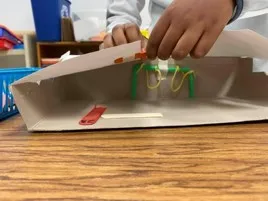The Case for Training Teachers in Object-Based Learning
Object-based learning is a pedagogical approach core to many museum experiences, inspiring close observation and deep critical thinking. An educator from the National Air and Space Museum shares how teachers can transfer these ideas to their own classrooms.
:focal(249x166:250x167)/https://tf-cmsv2-smithsonianmag-media.s3.amazonaws.com/filer_public/f9/22/f9227879-f4df-4d51-9073-bd00e580e3d7/nasmobj2.jpg)
Why Use Objects?
If active teaching is the goal, there is no better approach than to use objects. Objects are a tangible representation of concepts that have the ability to spark curiosity, make tangible connections to abstract ideas, develop skills, extend knowledge, and encourage close looking and examination. In addition, close looking at objects requires no particular content expertise, leveling the playing field for all learners. While museums are amazing places to visit to examine objects with students, the drawer of an old sewing machine, or the science department storage closet that has not been emptied in decades provides teachers with all manner of interesting objects to examine with their students.
Looking at an object for the first time helps learners build reasoning skills and provide evidence. A student may take a look at the Air France Concorde and say that it looks fast, which is certainly true. More importantly, it creates an invitation to deepen the examination and a check for understanding that comes from asking, “What makes you say that?” Not only do learners then have to put their ideas into words, but it gives the opportunity for other students to offer supporting evidence for the claim, or even refute it. The richness of discussion and the lively debate that follows is not possible when simply discussing a concept with words and text.
Objects provide a concrete start to a unit of study. Consider the different “hooks” to a unit on space exploration. A teacher might ask students what they know about space, eliciting answers both true and false and on topic and off the intended scope of learning. Alternatively, they might visit a museum and see (or use an image or 3D print) a flown space suit. Asking what questions they have about a specific object anchors the idea in something physical, allowing them to make tangible connections to something, and likely asking deeper questions. In the classroom, the start to a unit about ecosystems could begin with analysis of owl pellets or an animal skull, giving students an opportunity to examine something real to help formulate questions. To wrap up a unit and assess understanding, students could create their own exhibition with authentic or created objects to put it all together.

Using Objects in Real Classrooms
The Teacher Innovator Institute (TII) at the National Air and Space Museum is a professional development intensive for middle school STEAM teachers across the United States. Since 2018, over 100 teachers have been a part of the program which seeks to help bridge the gap between the classroom and informal learning spaces like museums. One of the goals of TII is to equip teachers with the tools of the museum educator, grounding them in the object-based learning and inquiry tools that are so successful in museum programs.
Melissa, a middle school STEM and product design teacher from Texas, turned a TII webinar on teaching with objects into an introductory unit for the school year, with the goals of building rapport with students and instilling the foundational skills of close looking that she continues to use throughout the school year. Students analyze a can of Coca-Cola (a classic object exploration exercise used across museum education programs) and are challenged to observe the object only, rather than applying their background knowledge about the content of the can or the company that makes it. They talk about the importance of background knowledge when examining new things, but also about the biases and stereotypes that previous experiences can bring into their learning. They use these same analysis skills to examine Melissa’s desk and gather clues about her as a person and a teacher, building classroom community and camaraderie.
Fifth-grade physical science teacher Lisa lets her students cut up onions in class to learn about the behavior of gasses and high school STEM teacher Trevor has his students look at mission patches from various space programs to learn about symbolism and the different types of objectives for space missions throughout history.
Teacher feedback from these experiences described students who were actively engaged and having “light bulb moments” as they worked together to formulate questions and think about possible solutions. With just simple, household objects in most cases, students of all backgrounds and abilities made connections to concepts that would previously have been taught using slide decks and textbooks.

Student Impacts
A small sample of students was studied during the 2020-2021 school year to determine if their teachers’ participation in the Teacher Innovator Institute impacted their engagement with STEAM concepts. Not only did over 80% of students rate their TII teacher as better than previous STEAM teachers, but more importantly, their attitudes toward STEAM learning changed for the better. Statistically significant increases were observed in “STEAM Fascination” and “Competency Beliefs”, categories in which students enjoy STEAM activities, are eager to talk about their learning with others, and are excited about mastering new skills; and in which they see themselves as being successful at tackling new STEAM challenges, respectively.
Conclusions
Museums like the National Air and Space Museum have the ability to reach millions of school-aged visitors each year, but can reach even more through teacher professional development programs that not only teach STEAM content, but leverage objects and constructivist teaching techniques to make concepts accessible to all types of learners. Equipping teachers with the ability to teach any content through the lens of objects and inquiry broadens our reach beyond just the teachers who teach aviation and spaceflight-related subjects, allowing the museum to impact students of all types and increase their attitudes and aptitudes in STEAM.
Editor's Note: To learn more about the Teacher Innovator Institute from the National Air and Space Museum and examples of the transfer of these ideas to the classroom, join Shannon Baldioli and a panel of Teacher Innovator Institute teacher alumni at the Smithsonian's National Education Summit on July 27-28, 2022. More information is available here: https://s.si.edu/EducationSummit2022
